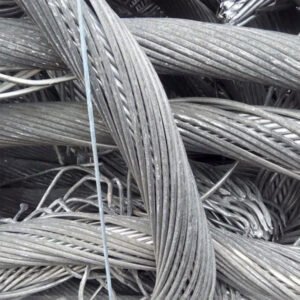Aluminum Wheel Scrap
Aluminum Wheel Scrap
We are a verified Importer & Exporter of high quality Aluminum Wheel Scrap. As a trusted name, we procure Aluminum Wheel Scrap only from the certified sources present in the market. We are capable of meeting both bulk as well as urgent requirements. Owing to our excellent logistics and wide distribution network, we are able to deliver the orders on the said time and at required destination.
These wheels are a valuable source of secondary aluminum due to aluminum’s infinite recyclability and the significant energy savings achieved by recycling compared to producing virgin aluminum.
Characteristics of Aluminum Wheel Scrap:
- Composition: Primarily aluminum alloy (typically 6xxx series alloys for automotive wheels), but often contains contaminants.
- Contaminants: Common contaminants include:
- Tires (rubber)
- Valve stems (rubber/metal)
- Wheel weights (lead, steel, or zinc)
- Steel inserts or lug nuts
- Dirt, grime, and debris
- Paint, clear coats, and other surface finishes
- Types/Grades:
- Clean Aluminum Rims/Wheels: Free of rubber tires, lead wheel weights, and steel attachments. These fetch the highest prices.
- Dirty Aluminum Rims/Wheels: May still have tires, weights, or other contaminants attached. These require more processing and thus have a lower value.
- Crushed/Shredded Aluminum Wheels: Wheels that have been processed to reduce their volume and sometimes remove initial contaminants.
- ISRI Code: Aluminum wheel scrap often falls under specific ISRI (Institute of Scrap Recycling Industries) codes, which define material specifications for trading. For instance, “TAINT/TABOR” generally refers to aluminum wheels.
Recycling Process:
The recycling of aluminum wheel scrap typically involves several key steps:
- Collection: Gathering discarded wheels from scrap yards, automotive repair shops, dealerships, and individual consumers.
- Sorting and Pre-Processing:
- Manual Sorting: Initial separation to remove obvious non-aluminum components like tires.
- Dismantling: Wheels may be de-mounted from tires, and weights removed.
- Shredding/Crushing: Wheels are often shredded or crushed into smaller pieces to facilitate further processing and increase density for transport.
- Magnetic Separation: Magnets are used to remove ferrous metals (steel lug nuts, steel weights).
- Eddy Current Separation: This technology uses magnetic fields to separate non-ferrous metals (aluminum) from other non-metallic materials (rubber, plastics).
- Optical Sorting: Advanced systems can differentiate between various aluminum alloys and remove non-aluminum materials.
- Cleaning: The shredded or crushed aluminum scrap is cleaned to remove paint, coatings, dirt, and other impurities. This can involve physical or chemical processes.
- Melting and Purification: The cleaned aluminum scrap is melted in a furnace at high temperatures. During melting, impurities are further removed through fluxing and skimming.
- Alloying: Depending on the desired properties for the new product, specific alloying elements (like silicon, magnesium, copper) are added to the molten aluminum to create the correct alloy specification.
- Casting and Forming: The molten aluminum alloy is then cast into new products, typically as ingots, billets, or slabs, which are then transported to manufacturers to be made into new aluminum products.
Uses and Applications:
Recycled aluminum from wheel scrap is highly versatile and is used in the production of a wide range of new aluminum products, including:
- New Automotive Parts: A significant portion of recycled aluminum wheels goes back into manufacturing new wheels, engine blocks, cylinder heads, and other structural components for the automotive industry, contributing to lightweighting and fuel efficiency.
- Aluminum Ingots: Remelted aluminum is cast into ingots for sale to foundries and manufacturers.
- Aluminum Cans: A common application for recycled aluminum.
- Construction Materials: Used in window frames, siding, and other architectural applications.
- Consumer Goods: Various household items and appliances.
Market Dynamics and Demand:
The market for aluminum wheel scrap is robust and growing, driven by several factors:
- Sustainability Push: Recycling aluminum saves up to 95% of the energy required for primary aluminum production and significantly reduces greenhouse gas emissions. This aligns with global decarbonization efforts and corporate ESG (Environmental, Social, and Governance) targets.
- Circular Economy: The ability to recycle aluminum indefinitely without losing its properties makes it a key material in the circular economy, reducing reliance on virgin raw materials.
- Automotive Industry Demand: The increasing demand for lightweight vehicles to improve fuel efficiency and reduce emissions makes recycled aluminum a crucial material for automotive manufacturers.
- Global Trade: Countries like India, China, and Southeast Asian nations are significant importers of aluminum scrap to feed their manufacturing industries. However, some countries are also implementing stricter import regulations for lower purity grades, favoring higher-quality scrap.
- Scrap Scarcity: Despite growing demand, there can be challenges with scrap availability, especially for higher purity post-consumer scrap, which can lead to rising input costs.
Pricing:
The price of aluminum wheel scrap varies based on:
- Purity/Cleanliness: Clean, de-mounted wheels command higher prices than those with contaminants (tires, weights, steel).
- Market Conditions: Global aluminum prices, supply and demand, and geopolitical factors influence scrap values.
- Regional Differences: Prices can vary significantly by location due to transportation costs, local demand, and regulations.
- Quantity: Larger volumes may fetch better per-unit prices.
(As of early June 2025, typical prices for “All Aluminum Rims” (clean) in the US might range from $0.40-$0.50/lb, or roughly $880-$1100 per metric ton, but these are highly dynamic and subject to change. Dirty aluminum would be significantly lower).
Regulations and Trade:
- HS Code: Aluminum waste and scrap typically fall under HS Code 760200 for international trade.
- Export/Import Regulations: Many countries have specific regulations, tariffs, or licensing requirements for the import and export of aluminum scrap, often aimed at securing domestic supply for their recycling industries or ensuring environmental compliance.
- Quality Standards: Buyers often require specific purity levels and contaminant limits, with SGS or other third-party inspections frequently requested for large international shipments.
In summary, aluminum wheel scrap is a valuable commodity in the recycling industry, playing a critical role in sustainable manufacturing and resource conservation, with a strong and growing global market demand.




Reviews
There are no reviews yet.